The global pharmaceutical chemicals market is estimated to be valued at USD 147.97 Bn in 2025 and is expected to reach USD 244.05 Bn by 2032, exhibiting a compound annual growth rate (CAGR) of 7.4% from 2025 to 2032.
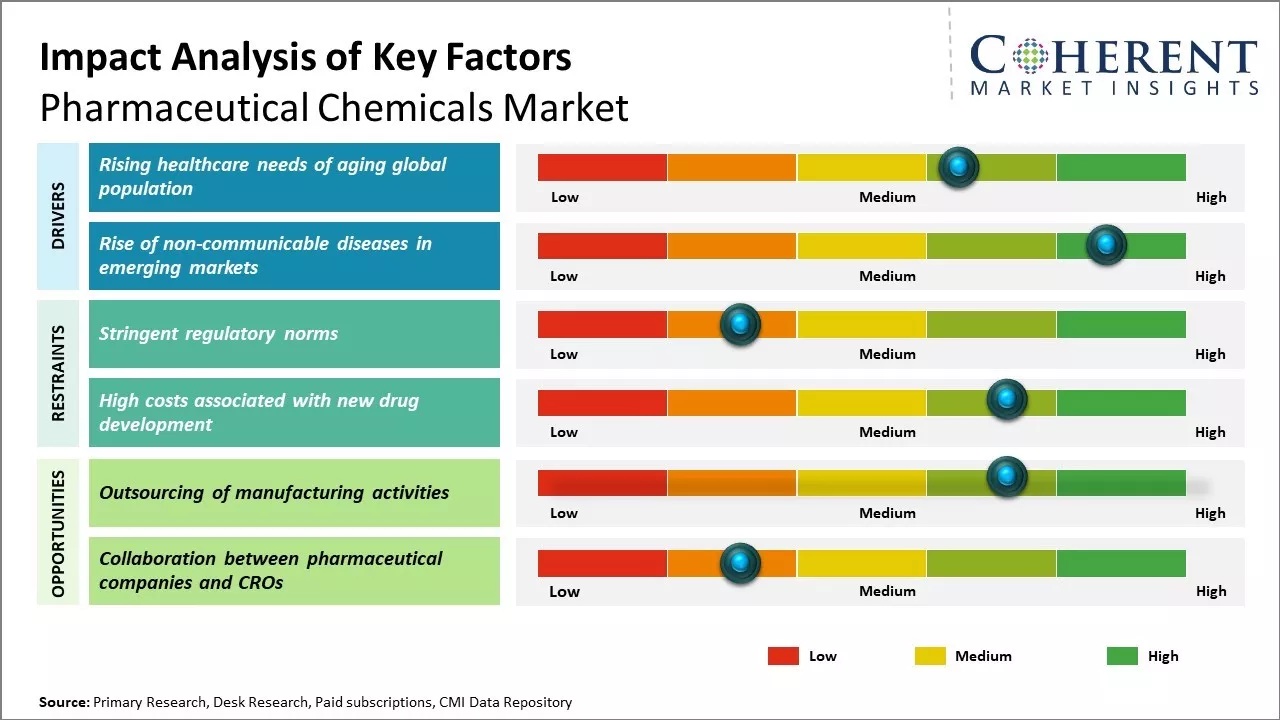
Discover market dynamics shaping the industry: Request sample copy
The market has been witnessing steady growth on account of increasing investments in R&D by major players and the growing generics market worldwide. Regulatory approvals and drug development have also accelerated. The demand for pharmaceutical chemicals is expected to be primarily driven by growth in the generics market globally over the coming years. Increasing prevalence of diseases globally is also supporting the need for development of new drug molecules. Further, the market is witnessing consolidation with major players undertaking mergers and acquisitions to expand their product pipelines. Innovation and development of specialty chemicals will present new growth opportunities in the market.
Rising healthcare needs of aging global population
As life expectancy increases and populations age around the world, the demand for pharmaceutical products and healthcare services is growing substantially. People are living longer with chronic diseases like diabetes, cancer, heart disease, and others which require long term medical treatment and management. According to the United Nations, the number of people aged 60 years and older is expected to more than double by 2050 and reach around 2 billion people globally. The aging population needs access to innovative drugs and therapies to improve quality of life and cope with health challenges. Pharmaceutical manufacturers are racing to develop specialized drugs targeting the healthcare needs of elderly patients. Many nations are also expanding healthcare coverage and access to medications for senior citizens. This widening segment of aging consumers presents a massive market opportunity for the pharmaceutical chemicals industry to supply active pharmaceutical ingredients and develop specialized medicines. The industry must prepare for steady long-term growth driven by the healthcare demands of a rapidly expanding global population of older individuals.
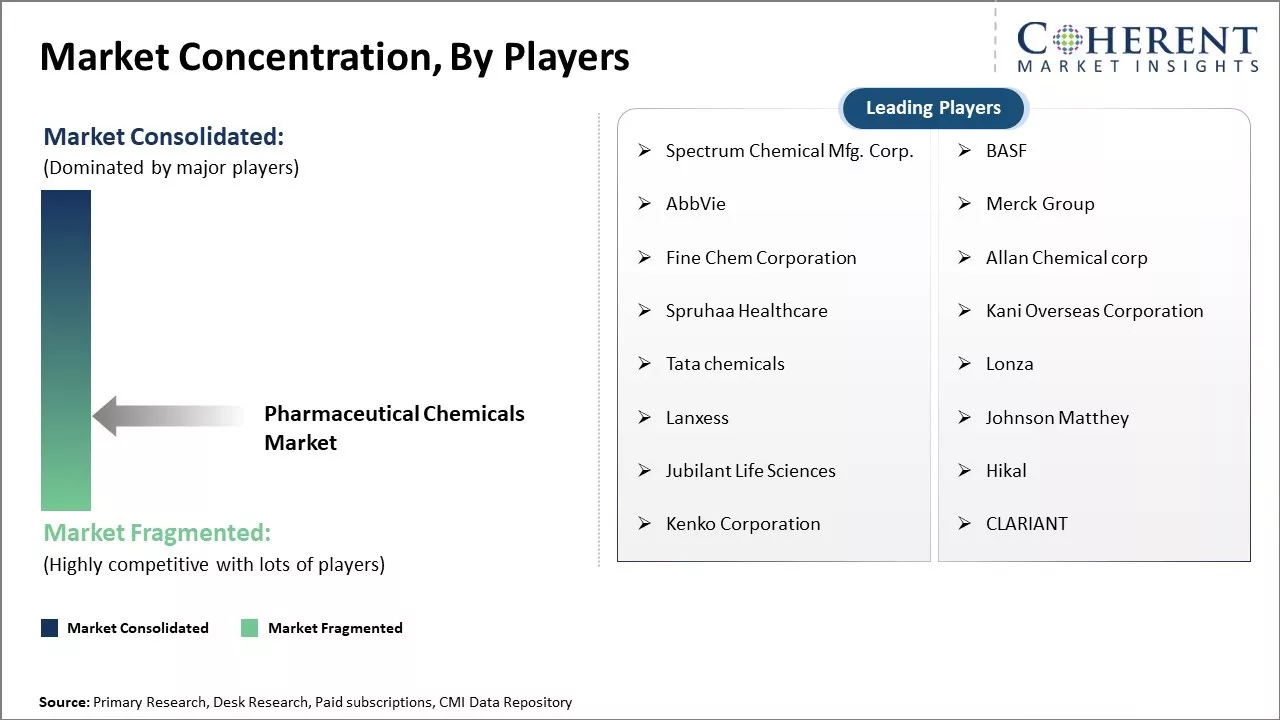
Get actionable strategies to beat competition: Request sample copy
Rise of non-communicable diseases in emerging marketsAnother important driver is the increasing rate of non-communicable diseases like cancer, diabetes, and cardiovascular diseases in developing nations. As emerging market economies progress and lifestyles become more sedentary, risk factors for these chronic illnesses are growing sharply. Countries that had previously only grappled with infectious diseases and undernutrition are now facing a dual burden of communicable and non-communicable diseases. Lack of access to primary healthcare and medical services compounds the problem in many developing regions. Multinational pharmaceutical companies and local drug makers have a significant chance to fill this treatment gap and expand accessibility of drugs combating cancer, diabetes, heart diseases and other common chronic conditions. The continuous economic growth and urbanization witnessed across Asia, Africa, Latin America, and other emerging markets is translating to a fast-rising patient base requiring long term medical care. Catering to this burgeoning patient pool of non-communicable diseases will be instrumental in sustaining high growth levels for the global pharmaceutical chemicals market in the coming decades.
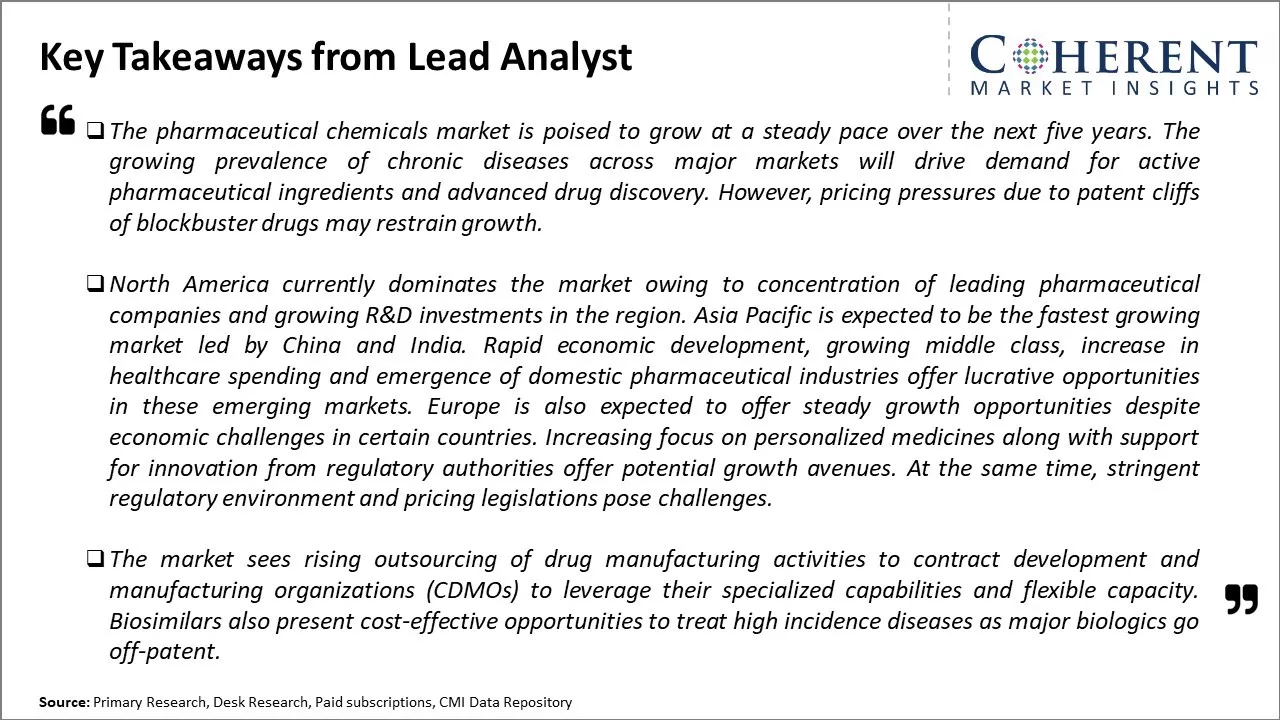
To learn more about this report, Request sample copy
Market Challenges: Stringent regulatory normsThe pharmaceutical chemicals market faces several challenges. Stringent regulatory norms around the globe have increased compliance costs for manufacturers. Additionally, the patent cliff of many blockbuster drugs has resulted in lower profit margins. Developing innovative drugs is a lengthy and expensive process. Furthermore, price control policies by governments have put downward pressure on prices. Rising prices of raw materials and changing trade policies have also negatively impacted production budgets.
Market Opportunities: Outsourcing of manufacturing activities
Outsourcing of manufacturing activities can bring new opportunities for growth in the pharmaceutical chemicals market. As pharmaceutical companies look to focus more on core activities like research & development and marketing, outsourcing of manufacturing processes can help optimize costs and drive efficiencies. This allows pharmaceutical companies to leverage the specialized manufacturing capabilities of contract manufacturers. Many contract manufacturers have made huge investments in setting up facilities with world-class production capabilities and quality systems as per global regulatory standards.
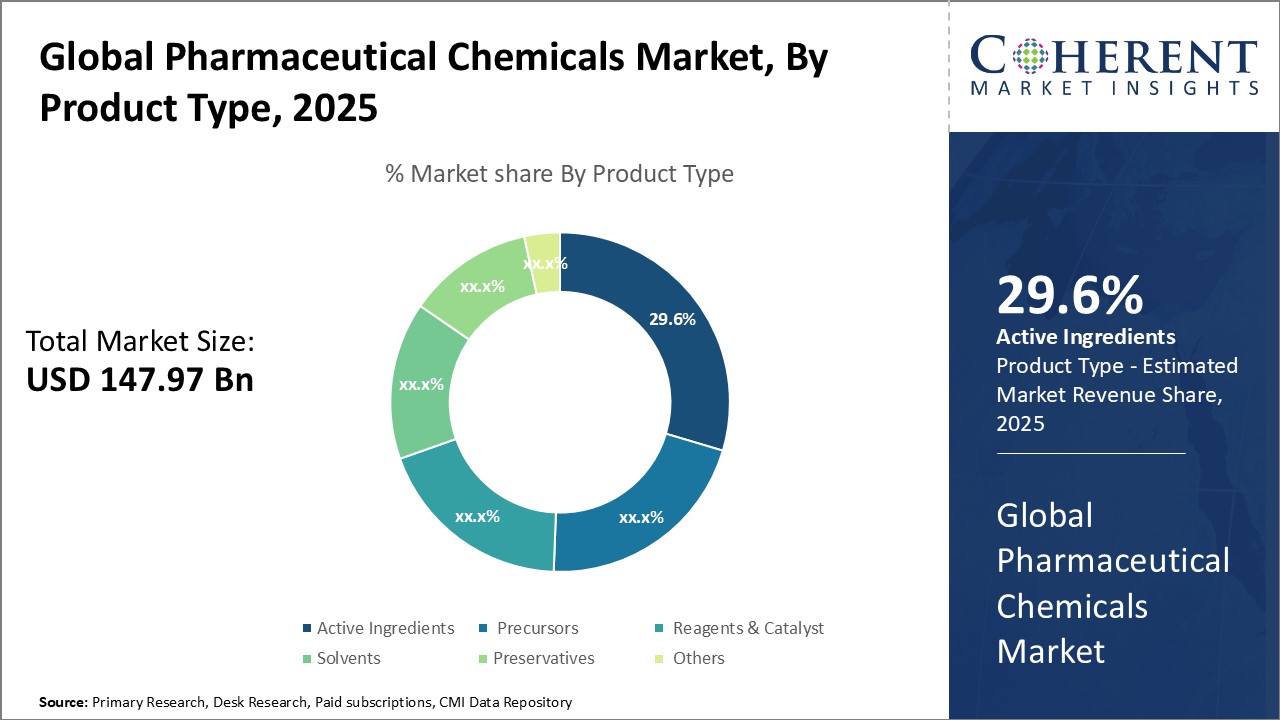
Discover high revenue pocket segments and roadmap to it: Request sample copy
Insights, By Product Type: Increase in the number of last stage pipeline drugsProduct type segment is sub-segmented into solvents, precursors, reagents & catalysts, active ingredients, preservatives, and others. Active ingredients segment is anticipated to hold 29.6% of the market share in 2025. Active pharmaceutical ingredients (APIs) are the medicinally active compounds that show biological effects in the body. As new diseases emerge and existing diseases spread, pharmaceutical companies are increasingly investing in R&D to discover innovative drugs. This has led to a surge in discovery of novel APIs over the past decade across a wide range of disease areas like cancer, diabetes, cardiovascular disorders etc. The demand for APIs is expected to further rise as the drug development pipeline remains robust. Several big pharma and biotech companies have hundreds of drugs in various stages of clinical trials. A large number of these experimental drugs will get approved and commercialized in the coming years if they prove to be safe and effective. This will translate into increased consumption of the underlying APIs during commercial manufacturing of these novel drugs. Moreover, patent expiries of blockbuster drugs are also prompting companies to develop improved successor drug candidates with better APIs.
Insights, By Drug Type: Large number of generic drugs available in the market
Drug type segment is sub-segmented into generic and branded. Generic segment is estimated to contribute the highest share of the pharmaceutical chemicals market and is projected to hold 65.3% of the market share in 2025. Generics are essentially identical copies of brand name drugs in dosage form, safety, strength and quality. They offer significant cost savings compared to their branded counterparts when patents expire. This makes generics highly attractive options for patients as well as governments trying to curtail healthcare expenditure. Both developing and developed countries have laid special emphasis on boosting generic consumption as part of their national health policies. For example, the Food and Drug Administration in the U.S. has undertaken various initiatives like generic drug user fee program to facilitate faster approvals of generic applications. This has enabled more off-patent branded drugs to be replaced swiftly by affordable generics. At the same time, large pharma firms are also promoting generic subsidiaries and acquiring generic drug companies. They aim to take advantage of the high-growth generic space as branded drugs are facing upward price control and payer pressure from governments worldwide.
Insights, By End User: Outsourcing of chemical manufacturing by pharma companies drives the CMO segment growth
End user segment is sub-segmented into pharmaceutical companies, CRO, CMO, and others. CMO segment is estimated to contribute the highest share of the pharmaceutical chemicals market and is projected to hold 32.6% of the market share in 2025. Pharmaceutical manufacturing is a highly specialized process that demands stringent regulatory compliance and quality consistency. It also involves substantial capital investment in setting up facilities, equipment, and maintaining infrastructure. To focus on their core competencies like R&D and marketing, big pharma companies now prefer outsourcing non-core operations like chemical manufacturing, sterile filling and packaging to specialized Contact Research Organizations (CROs) and Contract Manufacturing Organizations (CMOs). CRO/CMOs offer project-based customized services on scale with expert capabilities. They are able to produce large volumes of drugs at competitive costs for multiple pharma clients simultaneously at their existing facilities. Outsourcing strategies particularly help small biotech innovators who lack manufacturing capabilities to develop and supply their novel drugs. CMOs act as a one-stop-solution to produce clinical trial material or handle commercial supply chains. It also enables pharma companies to ramp up production quickly during a drug’s lifecycle without investing huge capital.
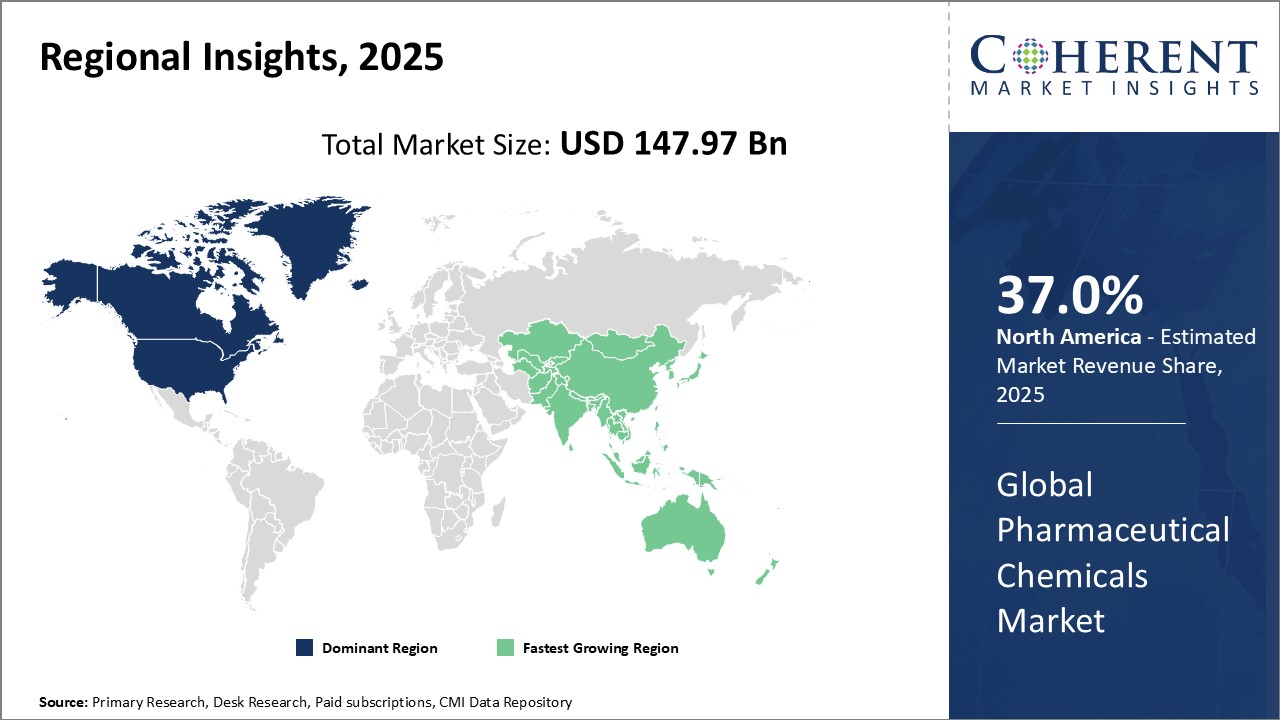
Need a Different Region or Segment? Customize now
The North America region has dominated the global pharmaceutical chemicals market for decades and is anticipated to hold 37.0% of the market share in 2025. The presence of major pharmaceutical companies along with advanced research capabilities have helped the region maintain its leading position. Several top American pharmaceutical players have large production facilities and R&D centers located across the U.S. and Canada. Additionally, supportive regulations around patents and intellectual property rights provide incentives for innovations. This has resulted in the region focusing more on developing novel drugs and biomarkers. The pharmaceutical chemicals should comply with stringent quality standards of regulatory bodies like the U.S. FDA. Local manufacturing helps in maintaining consistent supply chains and addressing the demands of the domestic market in a timely manner. North America also has a highly skilled workforce and necessary infrastructure for large-scale production. Major companies procure several raw materials from local suppliers, reducing import dependency. This has kept overall pricing competitive over the years despite high labor and production costs.
The Asia Pacific region has emerged as the fastest growing market for pharmaceutical chemicals globally in the recent past. Rapid expansion of the generics industry and presence of leading players from several emerging economies like India, China, and South Korea are driving the market growth. While China dominates pharmaceutical production volumes, India has specialized in active pharmaceutical ingredients (APIs). Governments in many Asia Pacific countries are promoting investments in pharmaceuticals through favorable policies. Improving regulatory guidelines and investment in infrastructure development have enhanced manufacturing capabilities.
Global Pharmaceutical Chemicals Market Report Coverage
| Report Coverage | Details | ||
|---|---|---|---|
| Base Year: | 2024 | Market Size in 2025: | USD 147.97 Bn |
| Historical Data for: | 2020 To 2024 | Forecast Period: | 2025 To 2032 |
| Forecast Period 2025 to 2032 CAGR: | 7.4% | 2032 Value Projection: | USD 244.05 Bn |
| Geographies covered: |
|
||
| Segments covered: |
|
||
| Companies covered: |
Spectrum Chemical Mfg. Corp., BASF, AbbVie, Merck Group, Fine Chem Corporation, Allan Chemical corp, Spruhaa Healthcare, Kani Overseas Corporation, Tata chemicals, Lonza, Lanxess, Johnson Matthey, Jubilant Life Sciences, Hikal, Kenko Corporation, and CLARIANT |
||
| Growth Drivers: |
|
||
| Restraints & Challenges: |
|
||
Uncover macros and micros vetted on 75+ parameters: Get instant access to report
*Definition: The pharmaceutical chemicals market consists of companies involved in the research and development, manufacturing, and distribution of bulk active pharmaceutical ingredients and key starting materials required for making drugs. These chemical components form the basic raw materials used widely by pharmaceutical drug manufacturers across various therapy areas such as cancer, diabetes, cardiovascular, neurological disorders, and others. The market also involves suppliers of specialized chemicals, reagents, and solvents used during the drug production process.
Share
Share
About Author
Vipul Patil is a dynamic management consultant with 6 years of dedicated experience in the pharmaceutical industry. Known for his analytical acumen and strategic insight, Vipul has successfully partnered with pharmaceutical companies to enhance operational efficiency, cross broader expansion, and navigate the complexities of distribution in markets with high revenue potential.
Missing comfort of reading report in your local language? Find your preferred language :
Transform your Strategy with Exclusive Trending Reports :
Frequently Asked Questions
Joining thousands of companies around the world committed to making the Excellent Business Solutions.
View All Our Clients
US Reciprocal Tax Impact Analysis On Global Pharmaceutical Chemicals Market
Stay updated on tariff changes with expert insights and timely information